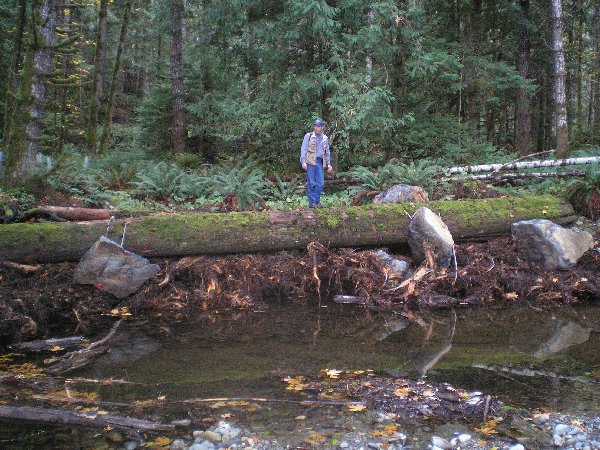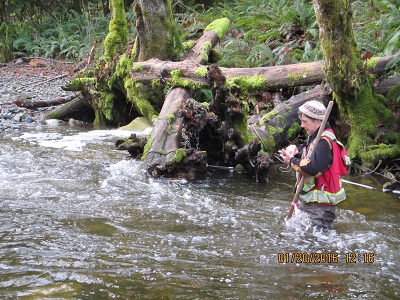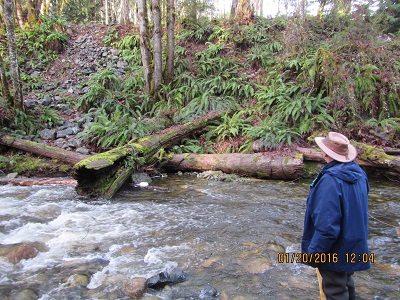Centre Creek
The Centre Creek watershed is a sub-basin comprising 21 square km of Englishman River watershed. The river enters South Englishman River approximately 250 m before its confluence with Englishman River. Centre Creek’s fish-bearing length is 16.5 km which includes 5.2 km of anadromous habitat.  The entire watershed is owned by 2 forest companies. It has a long history of timber harvesting which has affected the health of the stream. MVIHES has been instrumental in establishing a long-range restoration plan for this sub-basin.
The entire watershed is owned by 2 forest companies. It has a long history of timber harvesting which has affected the health of the stream. MVIHES has been instrumental in establishing a long-range restoration plan for this sub-basin.
A 2002 Overview of Fish and Fish Habitat by Clough and Morley found Centre Creek to have the highest abundance of juvenile fish in all the Englishman River watershed and was recommended for a more comprehensive assessment. Responding to that recommendation and the need for an action plan was “Restoration Plan: Detailed Salmon Habitat and Riparian Overview with Level B Prescriptions - Centre Creek Sub-Basin - Englishman River Watershed” completed in 2005 by Warren Warttig and Dave Clough.
 Restoration projects started in 2005 include:
Restoration projects started in 2005 include:
- An old smolt trap site was removed in Reach 1 (near the confluence).
- Riparian Restoration was completed with approximately 400 trees planted, standing timber thinned and 30 wildlife cavity habitats created in trees and on ground.
- Instream habitat was restored by anchoring Large Woody Debris (LWD) consisting of conifer stumps and on-site logs in the lower, anadromous reaches of Centre Creek. LWD is a natural way to protect the banks from erosion, plus narrow the stream channel to create riffles and deep shaded pools, thereby improving stream habitat productivity for coho and other salmonids
- Four test pits were dug in Reach 1 to determine feasibility of side channel development. The area was found to be not suitable for a side channel.
- Fresh blowdown from the clearcut side of the creek left an area of approximately 30 meters at high risk of further failure, likely causing damage to high value salmon habitat in the form of sedimentation and loss of stable LWD. The stability of the bank and LWD was restored with ballast rock, stumps and cabling.
 Restoration on this important tributary of the Englishman River continued in 2010 with funding from the Pacific Salmon Foundation and assistance from Copcan and TimberWest, the owner of the property. Twenty-five pieces of LWD, plus 3 truckloads of rip rap were placed and cabled against an eroding bank in the lower reach of the river. This project was directed by Dave Clough of DR Clough Consulting and rehabilitates 100 square meters of bank and instream habitat.
Restoration on this important tributary of the Englishman River continued in 2010 with funding from the Pacific Salmon Foundation and assistance from Copcan and TimberWest, the owner of the property. Twenty-five pieces of LWD, plus 3 truckloads of rip rap were placed and cabled against an eroding bank in the lower reach of the river. This project was directed by Dave Clough of DR Clough Consulting and rehabilitates 100 square meters of bank and instream habitat.
At the request of the Pacific Salmon Foundation, we re-visited all of the restoration sites to assess the success of the restoration efforts. On January 20, 2016 Dave Clough, the biologists who developed the restoration project, along with several MVIHES volunteers, conducted an assessment of the past decade of work. We were very pleased to learn that the rock and LWD structures are still in good condition. PLUS, the objectives of preventing steam bank erosion, and creating riffles and deep pools for fish habitat have been achieved. A very good outcome indeed!

